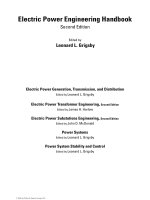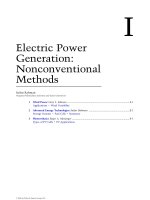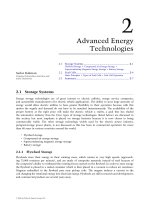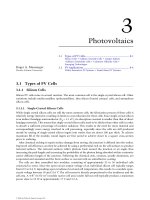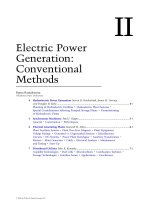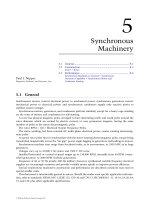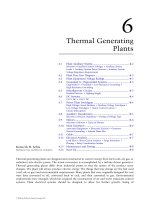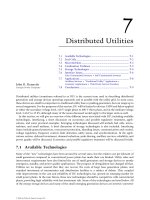Power system harmonics and passive filter designs (IEEE press series on power engineering) TQL
Bạn đang xem bản rút gọn của tài liệu. Xem và tải ngay bản đầy đủ của tài liệu tại đây (14.49 MB, 872 trang )
POWER SYSTEM
HARMONICS AND PASSIVE
FILTER DESIGNS
IEEE Press
445 Hoes Lane
Piscataway, NJ 08854
IEEE Press Editorial Board
Tariq Samad, Editor in Chief
George W. Arnold
Dmitry Goldgof
Ekram Hossain
Mary Lanzerotti
Vladimir Lumelsky
Pui-In Mak
Jeffrey Nanzer
Ray Perez
Linda Shafer
Zidong Wang
MengChu Zhou
George Zobrist
Kenneth Moore, Director of IEEE Book and Information Services (BIS)
POWER SYSTEM
HARMONICS AND PASSIVE
FILTER DESIGNS
J.C. DAS
Copyright © 2015 by The Institute of Electrical and Electronics Engineers, Inc.
Published by John Wiley & Sons, Inc., Hoboken, New Jersey. All rights reserved
Published simultaneously in Canada
No part of this publication may be reproduced, stored in a retrieval system, or transmitted in any form or
by any means, electronic, mechanical, photocopying, recording, scanning, or otherwise, except as
permitted under Section 107 or 108 of the 1976 United States Copyright Act, without either the prior
written permission of the Publisher, or authorization through payment of the appropriate per-copy fee to
the Copyright Clearance Center, Inc., 222 Rosewood Drive, Danvers, MA 01923, (978) 750-8400, fax
(978) 750-4470, or on the web at www.copyright.com. Requests to the Publisher for permission should
be addressed to the Permissions Department, John Wiley & Sons, Inc., 111 River Street, Hoboken, NJ
07030, (201) 748-6011, fax (201) 748-6008, or online at />Limit of Liability/Disclaimer of Warranty: While the publisher and author have used their best efforts in
preparing this book, they make no representations or warranties with respect to the accuracy or
completeness of the contents of this book and speciically disclaim any implied warranties of
merchantability or itness for a particular purpose. No warranty may be created or extended by sales
representatives or written sales materials. The advice and strategies contained herein may not be suitable
for your situation. You should consult with a professional where appropriate. Neither the publisher nor
author shall be liable for any loss of proit or any other commercial damages, including but not limited to
special, incidental, consequential, or other damages.
For general information on our other products and services or for technical support, please contact our
Customer Care Department within the United States at (800) 762-2974, outside the United States at
(317) 572-3993 or fax (317) 572-4002.
Wiley also publishes its books in a variety of electronic formats. Some content that appears in print may
not be available in electronic formats. For more information about Wiley products, visit our web site at
www.wiley.com.
Library of Congress Cataloging-in-Publication Data:
Das, J. C., 1934Power system harmonics and passive ilter design / J. C. Das.
pages cm
ISBN 978-1-118-86162-2 (hardback)
1. Electric power system stability. 2. Harmonics (Electric waves) 3. Electric ilters, Passive. I. Title.
TK1010.D37 2015
621.31′ 7–dc23
2014034588
Printed in the United States of America
10 9 8 7 6 5 4 3 2 1
CONTENTS
FOREWORD
xv
PREFACE
xix
ABOUT THE AUTHOR
xxi
CHAPTER 1
1.1
1.2
1.3
1.4
1.5
1.6
1.7
1.8
1.9
POWER SYSTEM HARMONICS
1
Nonlinear Loads 2
Increases in Nonlinear Loads 3
Effects of Harmonics
4
Distorted Waveforms 4
1.4.1 Harmonics and Power Quality
6
Harmonics and Sequence Components 7
1.5.1 Sequence Impedances of Power System Components
Harmonic Indices 9
1.6.1 Harmonic Factor 9
1.6.2 Equations for Common Harmonic Indices
9
1.6.3 Telephone Inluence Factor
10
Power Factor, Distortion Factor, and Total Power Factor
11
Power Theories 13
1.8.1 Single-Phase Circuits: Sinusoidal 13
1.8.2 Single-Phase Circuits: Nonsinusoidal
14
1.8.3 Three-Phase Systems
16
1.8.4 Nonsinusoidal and Unbalanced Three-Phase Systems
1.8.5 Instantaneous Power Theory 23
Ampliication and Attenuation of Harmonics
27
References 28
CHAPTER 2
FOURIER ANALYSIS
Periodic Functions 31
Orthogonal Functions
31
Fourier Series and Coeficients
33
Odd Symmetry
35
Even Symmetry 36
Half-Wave Symmetry 37
Harmonic Spectrum
41
Complex form of Fourier Series 41
Fourier Transform
43
2.9.1 Fourier Transform of Some Common Functions
2.10 Dirichlet Conditions
52
2.11 Power Spectrum of a Function
54
8
19
31
2.1
2.2
2.3
2.4
2.5
2.6
2.7
2.8
2.9
47
v
vi
2.12
2.13
2.14
CONTENTS
Convolution
56
2.12.1 Time Convolution
56
2.12.2 Frequency Convolution
56
2.12.3 The Convolution Derivative Theorem
2.12.4 Parseval’s Theorem
57
Sampled Waveform: Discrete Fourier Transform
2.13.1 Leakage
61
2.13.2 Picket Fence Effect 63
Fast Fourier Transform
64
2.14.1 Signal Flow Graph 69
References
69
CHAPTER 3
3.1
3.2
3.3
3.4
3.5
3.6
3.7
3.8
3.9
3.10
57
HARMONIC GENERATION-1
Harmonics in Transformers
71
3.1.1 Linear Model of a Two-Winding Transformer 71
3.1.2 B-H Curve and Peaky Magnetizing Current
75
3.1.3 Effect of Transformer Construction and Winding Connections
3.1.4 Control of Harmonics in Core Type Transformers
78
Energization of a Transformer 79
3.2.1 DC Core Saturation of Transformers
80
3.2.2 Sympathetic Inrush Current 82
Delta Windings of Three-Phase Transformers
82
3.3.1 Phase Shift in Three-Phase Transformers Winding Connections
3.3.2 Phase Shift for Negative Sequence Components
85
3.3.3 Distortion due to Saturation
90
3.3.4 Geomagnetically Induced Currents 90
Harmonics in Rotating Machine Windings 92
3.4.1 EMF of the Windings
94
3.4.2 Distribution Factor
94
3.4.3 Armature Reaction
96
Cogging and Crawling of Induction Motors 97
3.5.1 Harmonic Induction Torques
98
3.5.2 Harmonic Synchronous Torques 98
3.5.3 Tooth Ripples in Electrical Machines
101
Synchronous Generators
102
3.6.1 Voltage Waveform
102
3.6.2 Third Harmonic Voltages and Currents 103
Saturation of Current Transformers 104
Ferroresonance 105
3.8.1 Series Ferroresonance 108
3.8.2 Parallel Ferroresonance
109
Power Capacitors
111
Transmission Lines
112
References
112
CHAPTER 4
4.1
4.2
57
HARMONIC GENERATION–II
Static Power Converters 115
Single-Phase Bridge Circuit
115
71
76
84
115
CONTENTS
4.2.1 Phase Control 118
4.3 Reactive Power Requirements of Converters
122
4.4 Three-Phase Bridge Circuit 124
4.4.1 Cancellation of Harmonics Due to Phase Multiplication
129
4.4.2 Effect of Source Impedance
129
4.5 Harmonics on Output (DC) Side
133
4.6 Inverter Operation 135
4.7 Diode Bridge Converters
139
4.7.1 Half Controlled Bridge-Three-Phase Semi-Converters
139
4.8 Switch-Mode Power (SMP) Supplies 142
4.9 Home Appliances
143
4.10 Arc Furnaces
144
4.10.1 Induction Heating 146
4.11 Cycloconverters
147
4.12 Thyristor-Controlled Reactor 150
4.13 Pulse Width Modulation 154
4.13.1 Single Pulse Width Modulation 156
4.13.2 Multiple Pulse Width Modulation
157
4.13.3 Sinusoidal Pulse Width Modulation
157
4.14 Voltage Source Converters
158
4.14.1 Three-Level Converter 160
4.15 Wind Power Generation
162
4.15.1 Direct Coupled Induction Generator
162
4.15.2 Induction Generator Connected to Grid through Full Sized Converter
4.15.3 Doubly Fed Induction Generator 162
4.15.4 Harmonics in Wind Farms 164
4.16 Fluorescent Lighting
165
4.17 Adjustable Speed Drives 167
4.17.1 Voltage Fed Inverters
169
4.17.2 Current Source Inverter
170
4.17.3 Load Commutated Inverter
171
4.17.4 Cycloconverters 171
4.18 Pulse Burst Modulation
174
4.19 Chopper Circuits and Electric Traction
175
4.20 Slip Frequency Recovery Schemes
177
4.21 Power Semiconductor Devices 178
References 181
CHAPTER 5
INTERHARMONICS AND FLICKER
5.1 Interharmonics
183
5.1.1 Subsynchronous Interharmonics (Subharmonics)
5.2 Sources of Interharmonics 183
5.2.1 Imperfect System Conditions
184
5.2.2 Interharmonics from ASDs
186
5.2.3 HVDC Systems
189
5.2.4 Cycloconverters 191
5.3 Arc Furnaces
192
5.3.1 Induction Furnaces 195
5.4 Effects of Interharmonics 196
vii
162
183
183
viii
5.5
5.6
5.7
5.8
5.9
5.10
5.11
CONTENTS
Reduction of Interharmonics
198
Flicker
198
5.6.1 Perceptible Limits
198
5.6.2 Planning and Compatibility Levels 200
5.6.3 Flicker Caused by Arcing Loads
200
Flicker Testing 202
Control of Flicker 205
5.8.1 STATCOM for Control of Flicker 205
Tracing Methods of Flicker and Interharmonics
208
5.9.1 Active Power Index Method 208
5.9.2 Impedance-Based Method
209
5.9.3 Reactive Load Current Component Method
Torsional Analysis
210
5.10.1 Steady-State Excitation 212
5.10.2 Excitation from Mechanical System
213
5.10.3 Analysis
214
Subsynchronous Resonance 217
5.11.1 Series Compensation of Transmission Lines
5.11.2 Subsynchronous Resonance HVDC Systems
5.11.3 Subsynchronous Resonance Drive Systems
References
225
CHAPTER 6
6.1
6.2
6.3
6.4
6.5
6.6
6.7
6.8
6.9
6.10
6.11
6.12
209
217
218
224
HARMONIC REDUCTION AT THE SOURCE
Phase Multiplication
230
Varying Topologies 230
Harmonic Cancellation: Commercial Loads 232
Input Reactors to the PWM ASDs
235
Active Filters
237
6.5.1 Shunt Connection 237
6.5.2 Series Connection
237
6.5.3 Combination of Active Filters 242
6.5.4 Active Filter Conigurations
243
6.5.5 Active Filter Controls
243
6.5.6 Instantaneous Reactive Power Compensation 246
6.5.7 Corrections in the Frequency Domain 248
Active Current Shaping
248
Hybrid Connections of Active and Passive Filters 251
Impedance Source Inverters
255
Matrix Converters
259
Mutilevel Inverters
262
6.10.1 Flying Capacitor (Capacitor-Clamped) Inverters 265
6.10.2 Multilevel Inverters Using H-Bridge Converters
265
6.10.3 THMI Inverters 267
Switching Algorithms for Harmonic Control
270
Theory of Resultants of Polynomials
271
6.12.1 A Speciic Application
274
References
277
229
ix
CONTENTS
CHAPTER 7
ESTIMATION AND MEASUREMENTS OF HARMONICS
7.1 Waveform without Ripple Content
282
7.1.1 Geometric Construction for Estimation of Harmonics
283
7.1.2 Harmonic Estimation Using IEEE 519 Equations 286
7.2 Waveform with Ripple Content 288
7.2.1 Graphical Procedure for Estimating Harmonics with Ripple Content
7.2.2 Analytical Calculations
296
7.2.3 Effect of DC Reactor
298
7.3 Phase Angle of Harmonics
298
7.4 Measurements of Harmonics
304
7.4.1 Monitoring Duration 307
7.4.2 IEC Standard 6100 4-7
307
7.4.3 Measurement of Interharmonics
308
7.5 Measuring Equipment
309
7.5.1 Speciications of Measuring Instruments
310
7.5.2 Presentation of Measurement Results
311
7.6 Transducers for Harmonic Measurements
312
7.7 Characterizing Measured Data
314
7.8 Probabilistic Concepts
316
7.8.1 Histogram and Probability Density Function
319
7.8.2 Probability Distribution Function 319
7.8.3 Regression Methods: Least Square Estimation
320
7.9 Summation of Harmonic Vectors with Random Angles
323
7.10 Central Limit Theorem 326
7.11 Kalman Filtering 326
References 329
CHAPTER 8
EFFECTS OF HARMONICS
8.1 Rotating Machines 332
8.1.1 Induction Motors
332
8.1.2 Torque Derating 333
8.1.3 Pulsating Fields and Dynamic Stresses 334
8.2 Effect of Negative Sequence Currents on Synchronous Generators
335
8.3 Insulation Stresses 337
8.3.1 Common-Mode Voltages
338
8.3.2 Bearing Currents and Shaft Voltages
339
8.3.3 Effect of Cable Type and Length
341
8.4 Transformers 345
8.4.1 Losses in a Transformer 345
8.4.2 Derating of Transformers Supplying Nonlinear Loads 347
8.4.3 Harmonic Loss Factor for Winding Eddy Currents
349
8.4.4 Harmonic Loss Factor for Other Stray Loss 351
8.4.5 Calculations for Dry-Type Transformers
351
8.4.6 Calculations for Liquid-Filled Transformers
354
8.4.7 UL K Factor of Transformers
357
8.4.8 Inrush Current of Transformers 358
281
290
331
x
CONTENTS
8.5
8.6
8.7
8.8
8.9
8.10
8.11
8.12
Cables
359
Capacitors 361
Voltage Notching 362
EMI (Electromagnetic Interference) 363
8.8.1 FCC Regulations
367
Overloading of Neutral
367
Protective Relays and Meters
369
8.10.1 Modern MMPR (Multifunction Microprocessor-Based Relays)
8.10.2 Metering and Instrumentation 371
Circuit Breakers and Fuses
372
Telephone Inluence Factor 372
8.12.1 Psophometric Weighting 375
References
377
CHAPTER 9
9.1
9.2
9.3
9.4
9.5
9.6
9.7
9.8
9.9
9.10
9.11
9.12
9.13
9.14
9.15
9.16
9.17
10.1
10.2
10.3
10.4
10.5
10.6
HARMONIC RESONANCE
379
Two-Port Networks
379
9.1.1 High-Pass and Low-Pass Circuits 381
9.1.2 Half-Power Frequency
383
Resonance in Series and Parallel RLC Circuits 383
9.2.1 Series RLC Circuit
383
9.2.2 Parallel RLC Circuit
387
Practical LC Tank Circuit
391
Reactance Curves 396
Foster’s Networks
397
Harmonic Resonance 400
Harmonic Resonance in a Distribution System 404
Elusiveness of Resonance Problems
405
Resonance Due to Single-Tuned Filters 408
Switched Capacitors for Power Factor Improvement
9.10.1 Nearby Harmonic Loads
411
Secondary Resonance 411
Multiple Resonances in a Distribution Feeder 415
Part-Winding Resonance in Transformer Windings
Composite Resonance 419
Resonance in Transmission Lines
421
Zero Sequence Resonance
421
Factors Affecting Harmonic Resonance
423
References
424
CHAPTER 10
370
410
416
HARMONIC DISTORTION LIMITS ACCORDING TO STANDARDS
Standards for Limitation of Harmonics 427
10.1.1 IEC Standards
427
10.1.2 IEEE Standard 519 429
IEEE 519 Harmonic Current and Voltage Limits
Point of Common Coupling (PCC) 432
Applying IEEE 519 Harmonic Distortion Limits
Time Varying Characteristics of Harmonics
435
IEC Harmonic Current Emission Limits 436
429
433
427
CONTENTS
10.7 Voltage Quality
440
10.7.1 IEEE 519
440
10.7.2 IEC Voltage Distortion Limits 441
10.7.3 Limits on Interharmonics
441
10.8 Commutation Notches
444
10.9 Applying Limits to Practical Power Systems
References 450
CHAPTER 11
449
APPLICATION OF SHUNT CAPACITOR BANKS
11.1 Shunt Capacitor Banks 453
11.1.1 Power Factor Improvement 453
11.1.2 Voltage Support 454
11.1.3 Improve Active Power-Handling Capability
457
11.1.4 Application of Capacitors
457
11.2 Location of Shunt Capacitors
458
11.3 Ratings of Capacitors 459
11.3.1 Testing 460
11.3.2 Discharge Resistors
460
11.3.3 Unbalances
460
11.3.4 Short-Duration Overvoltage Capability
460
11.3.5 Transient Overcurrent Capability 462
11.4 Shunt Capacitor Bank Arrangements
465
11.4.1 Formation of a 500-kV Capacitor Bank 465
11.5 Fusing 468
11.5.1 Externally Fused
468
11.5.2 Expulsion-Type Fuses
470
11.5.3 Internally Fused
472
11.5.4 Fuseless 475
11.6 Connections of Banks 476
11.6.1 Grounded and Ungrounded Banks 477
11.6.2 Grounding Grid Designs
479
11.7 Unbalance Detection
479
11.7.1 Detuning due to Fuse Failure 481
11.8 Destabilizing Effect of Capacitor Banks 481
11.9 Switching Transients of Capacitor Banks
483
11.10 Control of Switching Transients 486
11.10.1 Resistance Switching
487
11.10.2 Point-of-Wave Switching or Synchronous Operation
11.11 Switching Capacitors with Motors 489
11.12 Switching Devices
490
11.12.1 High Voltages on CT Secondaries 496
11.13 Switching Controls 498
References 501
CHAPTER 12
453
488
MODELING OF SYSTEM COMPONENTS FOR HARMONIC
ANALYSIS
12.1 Transmission Lines
503
12.1.1 ABCD Constants
503
xi
503
xii
12.2
12.3
12.4
12.5
12.6
12.7
12.8
12.9
12.10
12.11
12.12
CONTENTS
12.1.2 Models with Respect to Line Length
505
12.1.3 Long-Line Model 506
12.1.4 Calculations of Line Constants 509
12.1.5 Three-Phase Line with Ground Conductors 513
12.1.6 Bundle Conductors
513
12.1.7 Carson’s Formula
515
12.1.8 Approximations to Carson’s Equations 517
12.1.9 Capacitance of OH lines 519
12.1.10 EMTP Models of OH Lines 524
12.1.11 Effects of Harmonics
526
12.1.12 Transmission Line Equations with Harmonics
527
Cables
532
12.2.1 Cable Constants 535
12.2.2 Capacitance of Cables
535
Zero Sequence Impedance of OH Lines and Cables
538
12.3.1 Grounding of Cable Shields
539
Filter Reactors 539
Transformers
540
12.5.1 Frequency-Dependent Models
541
12.5.2 Three-Winding Transformers
542
12.5.3 Four-Winding Transformers
545
12.5.4 Sequence Networks of Transformers 547
12.5.5 Matrix Equations 547
Induction Motors
554
Synchronous Generators
556
Load Models 557
12.8.1 Study Results with PQ and CIGRE Load Models 558
System Impedance
559
Three-Phase Models 561
Uncharacteristic Harmonics
563
Converters 564
References
566
CHAPTER 13
13.1
13.2
13.3
13.4
13.5
13.6
13.7
HARMONIC MODELING OF SYSTEMS
Electrical Power Systems
569
13.1.1 Harmonic Considerations
571
13.1.2 Effective Designs of Power Systems 572
Extent of Network Modeling 572
Impact of Loads and Generation 573
Short-Circuit and Fundamental Frequency Load Flow Calculations
Industrial Systems
578
Distribution Systems
582
13.6.1 The Radial System
582
13.6.2 The Parallel or Loop System
583
13.6.3 Network or Grid System 585
13.6.4 Primary Distribution System
585
13.6.5 Distribution System Harmonic Analysis 587
Transmission Systems 589
13.7.1 Ferranti Effect 591
569
574
CONTENTS
13.8
13.9
13.10
13.11
13.7.2 Surge Impedance Loading 592
13.7.3 Transmission Line Voltages
593
Compensation of Transmission Lines
593
13.8.1 Z0 Compensation
593
13.8.2 Line Length Compensation
594
13.8.3 Compensation by Sectionalizing the Line
595
13.8.4 Relection Coeficients
597
Commercial Buildings
598
Residential Loads 599
HVDC Transmission
599
13.11.1 HVDC Light 600
13.11.2 HVDC Conigurations and Operating Modes 600
13.11.3 DC Filters
602
References 605
CHAPTER 14
14.1
14.2
14.3
14.4
14.5
14.6
14.7
14.8
14.9
14.10
14.11
14.12
14.13
14.14
14.15
xiii
HARMONIC PROPAGATION
607
Harmonic Analysis Methods 608
Frequency Domain Analysis
608
Frequency Scan 610
Voltage Scan 611
Harmonic Analysis Methods 612
14.5.1 Current Injection Method
612
14.5.2 Forward and Backward Sweep
613
14.5.3 Iterative Newton–Raphson Method
615
14.5.4 A Three-Phase Harmonic Load Flow
618
Time Domain Analysis
620
Sensitivity Methods
620
Unbalanced AC System and HVDC Link 622
Hybrid Frequency and Time Domain Concept
623
Probabilistic Concepts
626
Computer-Based Programs 631
Harmonic Analyses of a Large Industrial System
632
14.12.1 Objectives of Study 632
14.12.2 Harmonic Emission Model
634
14.12.3 Harmonic Propagation, Case 1
634
14.12.4 Harmonic Propagation, Case 2
639
14.12.5 Harmonic Propagation, Case 3
641
Long Transmission Line
653
34.5 kV UG Cable
673
5-Bus Transmission System 673
References 682
CHAPTER 15
PASSIVE FILTERS
15.1 Filter Types
685
15.1.1 Shunt and Series Filters
689
15.1.2 Location of Harmonic Filters
15.2 Single-Tuned Filters
690
15.2.1 Tuning Frequency
694
685
689
xiv
15.3
15.4
15.5
15.6
15.7
15.8
15.9
15.10
15.11
15.12
15.13
15.14
15.15
15.16
15.17
15.18
15.19
CONTENTS
15.2.2 Minimum Filter
694
15.2.3 Shifted Resonant Frequencies
695
15.2.4 Effect of Tolerances on Filter Components 696
15.2.5 Iterative Design Requirements 697
15.2.6 Outage of One of the Parallel Filters
697
15.2.7 Operation with Varying Loads 698
15.2.8 Division of Reactive kvar Between Parallel Filter Banks
15.2.9 Losses in the Capacitors 698
Harmonic Filter Detuning and Unbalance
699
Relations in an ST Filter
699
Selection of Q Factor
701
Double-Tuned Filter 702
Bandpass Filters 704
Damped Filters 705
15.8.1 Second-Order High-Pass Filter 707
Type C Filter
710
Zero Sequence Traps 716
Series-Type Low-Pass Filter 717
Transfer Function Approach for Filter Designs
718
Optimization Techniques of Filter Designs
723
15.13.1 Interior Penalty Function Method
724
15.13.2 Interior Point Methods and Variants
725
15.13.3 Karmarkar Interior Point Algorithm
726
15.13.4 Barrier Methods 727
Genetic Algorithms for Filter Designs
728
15.14.1 Particle Swarm Optimization (PSO) 730
HVDC–DC Filters
731
Limitations of Passive Filters 734
Flowchart for Design of Filters 735
Filter Components
735
15.18.1 Filter Reactors
735
15.18.2 Filter Resistance Assemblies 738
Failure of Harmonic Filters 741
References
741
CHAPTER 16
16.1
16.2
16.3
16.4
16.5
16.6
16.7
PRACTICAL PASSIVE FILTER DESIGNS
Study 1: Small Distribution System with Major Six-Pulse Loads
Study 2: Filters for Arc Furnance Loads 756
Study 3: Filters for Two 8000-Hp ID Fan Drives 770
Study 4: Double-Tuned ilter on a Three-Winding Transformer
Study 5: PV Solar Generation Plant
785
16.5.1 Solar Plant Considered for Harmonic Analysis 789
Study 6: Impact of Harmonics at a Distance 799
Study 7: Wind Generation Farm 804
16.7.1 Model for Harmonic Studies
810
INDEX
698
745
745
782
829
FOREWORD
Dr. Jean Mahseredjian1
This book on power system harmonics and passive ilter designs is a comprehensive
resource on this subject, covering harmonic generation, mitigation, measurement and
estimation, limitations according to IEEE and IEC standards, harmonic resonance,
formation of shunt capacitor banks, modeling of power system components and systems. Harmonic penetration in the power systems, passive ilters, and typical study
cases, covering renewable energy sources – solar and wind power generation – are
included. There are many aspects of harmonics discussed in this book, which are not
covered in the current publications.
The following is a chapter-wise summary of the book content.
Chapter 1 forms a background on the subject of power system harmonics with
discussions of harmonic indices and power theories. The coverage of nonsinusoidal
single-phase and three-phase systems and popular instantaneous power theory of H.
Akagi and A. Nabe, much used for active ilter designs discussed later on in the book,
leads a reader to understand the nonlinearity.
The second chapter on Fourier analysis, though much mathematical, paves the
way for the applications to harmonic analysis and measurements with limitations of
window functions. The examples given in the chapter help the readers to understand
the transformations.
Harmonic generation from conventional power equipment, ferroresonance,
and electronically switched devices, converters, home appliances, cycloconverters,
PWM, voltage source converters, switch mode power supplies, wind farm generation, pulse burst modulation, chopper circuits, traction and slip recovery schemes,
are well described in Chapters 3 and 4. A reader will ind an interesting analysis
of transformer modeling, third harmonic voltages in generators, and many EMTP
simulations. Harmonics due to saturation of current transformers is an added feature.
Chapter 4 is fairly exhaustive and includes harmonic generation from many sources
of practical importance. The analysis and topologies of ASDs (adjustable speed
drives) are well documented. Though the author provides some background, yet a
reader must be conversant with elements of power electronics.
Interharmonics is a new ield of research, and Chapter 5 is well written so as to
provide a reader a clear concept of interharmonic generation and their effects. This
is followed by a well-written work on licker from arcing loads, arcing and induction
1 Dr. Jean Mahseredjian is an IEEE-Fellow and Professor of Electrical Engineering at École Polytechnique
de Montréal, Montréal, Québec, Canada. He is world renowned authority on the simulation and analysis of
electromagnetic transients. He was also a member of IEEE working groups on Power System Harmonics.
xv
xvi
FOREWORD
furnaces, and tracing methods of licker. The control of licker through the application
of a STATCOM followed by torsional analysis due to harmonics in large drives with
graphics is one problem that is not so well addressed in current texts. The subsynchronous resonance in series compensated HV transmission lines and drive system
cascades, with EMTP simulation results, will be of interest to special readers interested in this ield.
Having discussed the generation of harmonics in previous chapters, Chapter 6 is
logically placed to discuss the various strategies that can be adopted to reduce the harmonics at source itself, so that harmonic penetration in the power systems is avoided.
This covers active ilters, combination of active and passive ilters, their controls,
active current shaping matrix converters, multilevel inverters, THMI inverters and
theory of harmonic reduction at source, new breed of matrix and multilevel converters, followed with the theory of the resultant of polynomials. Then, the demonstration
of this theory and control of switching angles is demonstrated to reduce harmonic
distortion to a very low level. Some sections of this chapter will need a prior understanding of many aspects of converters and their switching, and on irst reading the
mathematical treatment cannot be easily followed by an average reader. The author
provides excellent references at each step for further reading.
The calculations, estimation, time stamp of harmonics are the irst step before a
model can be generated for study. The relevance of modeling angles of the harmonics,
measuring equipment, transducers, analysis of various waveforms will be of interest
to all readers, while probabilistic concepts, regression methods, Kalman iltering, and
so on will be of special interest. The author provides fundamental aspects leading to
these advanced concepts.
The effects of harmonics can be very deleterious on electrical power equipment,
Chapter 8. Practically all power system equipment of interest, motors, insulation
stresses, and traveling wave phenomena on drive system cables, common mode voltages, bearing currents, protective relaying, circuit breakers, and the like are covered.
Of special interest to a reader will be derating of dry and liquid-illed transformers
serving nonlinear loads, which at times may be ignored, resulting in overloads.
After this background is grasped, harmonic resonance in various forms is discussed in Chapter 9. The reactance curves, Foster networks, composite resonance,
secondary resonance are illustrated, which are commonly missing topics in other
texts.
The limits of harmonic distortions in Chapter 10 cover both, IEEE and IEC
guidelines, with limits on interharmonics and calculations of effects of notching on
harmonic distortions.
In the design of passive ilters, formation of shunt capacitor banks and their
grounding and protection is an important aspect, Chapter 11. Often failures on harmonic ilters occur due to improper selection of the ratings of unit capacitors forming
the bank, as well as ignoring their protection and switching transients. The importance of this chapter cannot be overstated for a reader involved in harmonic ilter
designs.
The next step in harmonic analysis is accurate modeling of power system components and power systems, depending on their nature and extent of study, which is
detailed in Chapters 12 and 13. These two chapters form the backbone of harmonic
FOREWORD
xvii
analysis. The modeling described for transmission lines, transformers, loads, cables,
motors, generators, and converters in Chapter 12 is followed by system modeling in
industrial, distribution, and transmission systems and HVDC, which are the aspects
that should be clearly grasped by a reader interested in harmonics.
Study of harmonic penetration discussed in Chapter 14 can be undertaken
after the material in the previous chapters is grasped. Apart from time and frequency
domain methods, the chapter covers the latest aspects of probabilistic modeling.
It may seem that in the entire book only one chapter, Chapter 15, is devoted
to passive ilters. However, harmonic ilter designs may be called the last link of the
long chain of harmonic studies. The chapter describes practically all types of passive
ilters commonly applied in the industry, with some new technologies such as genetic
algorithms and particle swarm theories.
Lastly, Chapter 16 has many real-world studies of harmonic analysis and ilters designs, including arc furnaces, transmission systems, solar and wind generation
plants. A reader with adequate modeling tools and software can duplicate these studies and it will be a tremendous exercise in learning.
I conclude that the book is well written and should appeal to beginners and
advanced readers, in fact, this can become a standard reference book on harmonics.
Many solved examples and real-world simulations of practical systems enhance the
understanding. The book is well illustrated with relevant igures in each chapter.
PREFACE
The power system harmonics is a subject of continuous research; this book attempts
to present the state-of-art technology and advancements. It is a subject of interest of
many power system professionals engaged in harmonic analysis and mitigation and
the applications in the modern climate when the nonlinear loads in the utility systems
are on the increase.
The book provides a comprehensive coverage of generation, effects, and control
of harmonics. New harmonic mitigation technologies, detailed step-by-step design of
passive ilters, interharmonics, and licker are covered. The intention is that the book
can serve as a reference and practical guide on harmonics.
A beginner should be able to form a clear base for understanding the subject of
harmonics, and an advanced reader’s interest should be simulated to explore further.
A irst reading of the book followed by a detailed critical reading is suggested. The
many real-world study cases, examples, and graphics strive for this objective and
provide clear understanding. The subject of harmonics may not form a curriculum
even for graduate studies in many universities. In writing this book, an undergraduate
level of knowledge is assumed; yet, the important aspects with respect to connectivity
of each chapter are not lost sight of. It has the potentiality of serving as advance
undergraduate and graduate textbook. Surely, it can serve as continuing education
textbook and supplementary reading material.
The effects of harmonics can be experienced at a distance, and the effect on
power system components is a dynamic and evolving ield. These interactions have
been analyzed in terms of current thinking.
The protective relaying has been called “an art and science.” The author
will not hesitate to call the passive harmonic ilter designs and mitigation technologies the same. This is so because much subjectivity is involved. Leaving aside
high-technology research tools such as Monte Carlo simulations, the available computer techniques invariably require iterative studies to meet a number of conlicting
objectives.
A irst reading of the book will indicate that the reader must understand the
nature of harmonics, modeling of power system components, and characteristics of
ilters, before attempting a practical ilter design for real-world applications. Chapter
16 is devoted to practical harmonic passive ilter designs and case studies including
solar and wind generation. A reader can modal and reproduce the results and get a
“feel” of the complex iterative and analytical procedures.
xix
xx
PREFACE
The author acknowledges with thanks permission for republication of
some work from his book: Power System Analysis: Short-Circuit Load Flow and
Harmonics, CRC Press.
J.C. Das
ABOUT THE AUTHOR
J.C. Das is principal and consultant with Power System Studies, Inc. Snellville,
Georgia. He headed the Power System Analysis department at AMEC, Inc. for many
years. He has varied experience in the utility industry, industrial establishments,
hydroelectric generation, and atomic energy. He is a specialist in performing power
system studies, including short circuit, load low, harmonics, stability, arc lash
hazard, grounding, switching transients, and protective relaying. He conducts
courses for continuing education in power systems and has authored or coauthored
about 65 technical publications nationally and internationally. He is the author of the
following books:
• Arc Flash Hazard Analysis and Mitigation, IEEE Press, 2012.
• Transients in Electrical Systems: Analysis Recognition and Mitigation,
McGraw-Hill, 2010
• Power System Analysis: Short-Circuit Load Flow and Harmonics, Second
Edition, CRC Press, 2011.
These books provide extensive converge, running into more than 2400 pages
and are well received in the technical circles. His interests include power system
transients, EMTP simulations, harmonics, power quality, protection, and relaying.
He has published 200 study reports on electrical power system for his clients.
Related to harmonic analysis, Mr. Das has designed some large harmonic passive ilters in the industry, which are in successful operation for more than 18 years.
Mr. Das is a Life Fellow of Institute of Electrical and Electronics Engineers,
IEEE (United States), Member of the IEEE Industry Applications and IEEE Power
Engineering societies, a Fellow of Institution of Engineering Technology (United
Kingdom), a Life Fellow of the Institution of Engineers (India), a Member of the
Federation of European Engineers (France), and a member of CIGRE (France). He
is a registered Professional Engineer in the States of Georgia and Oklahoma, a Chartered Engineer (C. Eng.) in the United Kingdom and a European Engineer (Eur. Ing.)
in the Europe. He received meritorious award in engineering, IEEE Pulp and Paper
Industry in 2005.
He received MSEE degree from the Tulsa University, Tulsa, Oklahoma, and
BA (advanced mathematics) and BEE degrees from the Punjab University, India.
xxi
CHAPTER
1
POWER SYSTEM HARMONICS
The electrical power systems should be designed not only for the sinusoidal currents
and voltages but also for nonlinear and electronically switched loads. There has been
an increase in such loads in the recent times, and these can introduce harmonic pollution, distort current and voltage waveforms, create resonances, increase the system
losses, and reduce the useful life of the electrical equipment. Harmonics are one of
the major problems of ensuring a certain power quality. This requires a careful analysis of harmonic generation and their measurements and the study of the deleterious
effects, harmonic controls, and limitation to acceptable levels. Interest in harmonic
analysis dates back to the early 1990s in connection with high voltage DC (HVDC)
systems and static var compensators (SVC; Reference [1]). The analytical and harmonic limitation technology has progressed much during this period (see Reference
[2] for a historical overview of the harmonics in power systems).
DC power is required for a number of applications from small amount of power
for computers, video equipment, battery chargers, UPS (uninterrptible power supplies) systems to large chunks of power for electrolysis, DC drives, and the like. A
greater percentage of ofice and commercial building loads are electronic in nature,
which have DC as the internal operating voltage. Fuel and solar cells and batteries can
be directly connected to a DC system, and the double conversion of power from DC to
AC and then from AC to DC can be avoided. A case study conducted by Department
of Electrical Power Engineering, Chalmers University of Technology, Gothenburg,
Sweden is presented in [3]. This compares reliability, voltage drops, cable sizing,
grounding and safety: AC verses DC distribution system. In Reference [4], DC shipboard distribution system envisaged by US Navy is discussed. Two steam turbine
synchronous generators are connected to 7000 V DC bus through rectiiers, and DC
loads are served through DC–DC converters. However, this is not a general trend,
bulk and consumer power distribution systems are AC; and we will not be discussing
industrial or commercial DC distribution systems in this book, except that HVDC
converter interactions with respect to harmonics and DC ilters are of interest and
discussed in the appropriate chapters.
Harmonics in power systems originate due to varied operations, for example,
ferroresonance, magnetic saturation, subsynchronous resonance, and nonlinear
and electronically switched loads. Harmonic emission from nonlinear loads
predominates.
Power System Harmonics and Passive Filter Designs, First Edition. J.C. Das.
© 2015 The Institute of Electrical and Electronics Engineers, Inc. Published 2015 by John Wiley & Sons, Inc.
1


